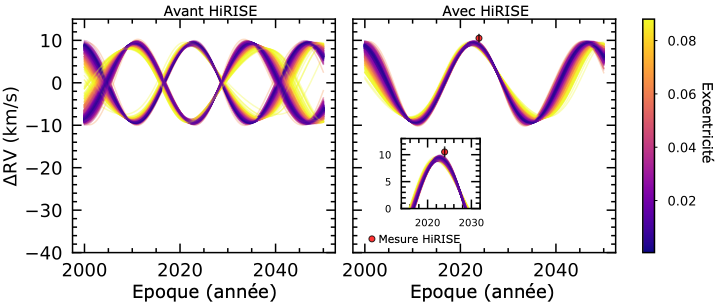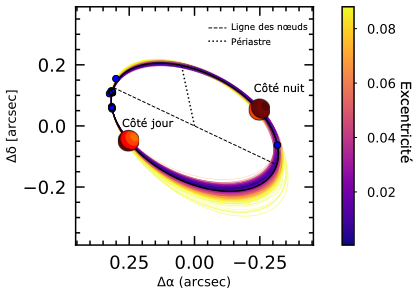HiRISE: Length of day on a Jupiter-like exoplanet
Thanks to the HiRISE instrument, scientists from CNRS Terre & Univers have been able to characterize the young Jupiter-like exoplanet AF Lep b.
Direct measurement of the light emitted by young giant exoplanets gives us access to the composition of their atmosphere, and enables us to study how they formed. In addition to composition, high spectral resolution spectroscopy gives access to parameters such as orbital velocity or the speed at which planets spin on themselves, which are also parameters linked to their formation history. This study focuses on the young exoplanet AF Lep b, which is a Jupiter analogue in our Solar System, with a mass around three times greater than the latter and orbiting at twice the distance.
New measurements taken with the HiRISE instrument have revealed that the planet is turning on itself at a speed of around 12 km/s. Given its diameter, which is 30% greater than that of Jupiter, this means that the planet can be estimated to turn on itself in just under eleven hours. This result confirms the analogy with Jupiter, which rotates on itself in around 10 hours. The scientists also measured the planet’s speed on its orbit, enabling them to constrain its orbit very precisely (Figure 1) and to determine which side of the planet is facing the observer (Figure 2).


This unique result was made possible by HiRISE, an innovative instrument designed and built by the Laboratoire d’Astrophysique de Marseille for the Very Large Telescope (VLT) in Chile. Thanks to HiRISE, direct characterization of exoplanets has entered a new era, enabling spectroscopy at a spectral resolution 1,000 times greater than that achieved by existing exoplanet imaging instruments.
AF Lep b is just the first target of the HiRISE survey, due to start in 2023. Within a few years, all the giant planets known from imaging will have been observed with HiRISE, enabling us to statistically test the links between composition, rotation speed and mode of formation.
CNRS Laboratories involved
- Laboratoire d’astrophysique de Marseille (LAM – OSU Pythéas)Tutelles : CNRS / CNES / AMU
- Laboratoire Joseph-Louis Lagrange (LAGRANGE – OCA)Tutelles : CNRS / Observatoire de la Côte d’Azur / Univ Côte d’Azur
- Laboratoire d’Instrumentation et de Recherche en Astrophysique (LIRA -Observatoire de Paris – PSL)Tutelles : CNRS / Observatoire de Paris – PSL / Sorbonne Univ / Univ Paris Cité
- Institut de planétologie et d’astrophysique de Grenoble (IPAG – OSUG)Tutelles : CNRS / UGA
- Institut de Recherche en Astrophysique et planétologie (IRAP – OMP)Tutelles : CNRS / CNES / Université de Toulouse
Further Resource
- A. Denis, A. Vigan, et al. Characterization of AF Lep b at high spectral resolution with VLT/HiRISE, A&A 696 A6 (2025)
IRAP Contact
- Alexis Lavail, alexis.lavail@irap.omp.eu






